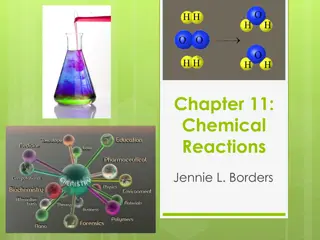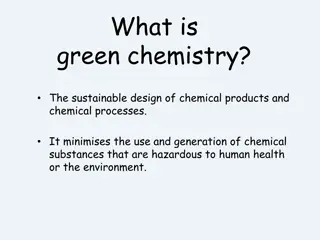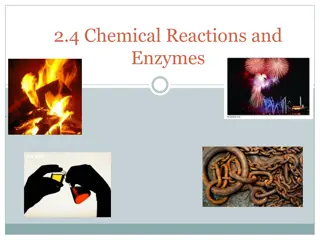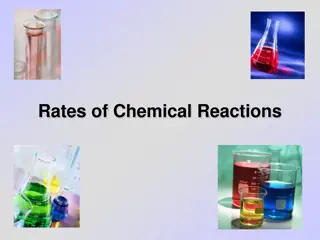Understanding Atom Economy in Chemical Reactions
Explore the concept of atom economy in chemistry, learn how to calculate atom economy of a reaction, and understand why it is important for industrial processes. Watch a video, answer questions, and practice with worked examples and self-assessment tasks to grasp the significance of efficient industrial processes.
Download Presentation

Please find below an Image/Link to download the presentation.
The content on the website is provided AS IS for your information and personal use only. It may not be sold, licensed, or shared on other websites without obtaining consent from the author. Download presentation by click this link. If you encounter any issues during the download, it is possible that the publisher has removed the file from their server.
E N D
Presentation Transcript
Atom Economy DNA:
Progress indicators Good progress: - State what is meant by atom economy - Calculate the atom economy of a reaction Outstanding progress: -Explain why atom economy is important to industrial processes
Task: Watch the video and answer the following question: https://www.youtube.com/watch?v=Zuyk4hfbjSA 1. What is atom economy? 2. What is the calculation for atom economy? 3. What would the atom economy be for a reaction where only one product forms. 4. What is the atom economy for the second example question? 5. Why is it important that industries work towards the most efficient industrial processes? 6. Efficient processes conserve more _______ ________ and produce _____ ________.
Self-assessment: 1. Atom economy tell us the amount of product that was useful as a percentage of all the products formed. 2. Percentage atom economy = x 100% 3. The atom economy would be 100% if only one product formed. 4. Atom economy for the second example question would be 29.5% 5. It is important to ensure high atom economy as this ensures sustainable development. 6. Efficient processes conserve more natural resources and produce less waste.
Worked example: The following shows a reaction for making hydrogen from methane: CH4 + H2O CO + 3H2 Calculate the atom economy for making hydrogen in this reaction Remember: The first thing to figure out is what is the desired product? Next, calculate the Mr of the desired product and of each of the reactants (for this calculation you multiply the Mr by the no. of moles) Then, calculate the atom economy using the equation
CH4 + H2O CO + 3H2 The desired product is hydrogen Mr of desired product = 2, multiplied by number of moles = 2 x 3 = 6 Mr of reactants = - CH4 = 12 + (4 x 1) = 16 - H2O = (1 x 2) + 16 = 18 - Total = 16 + 18 = 34 Atom economy = 6 / 34 = 0.18 x 100 = 18%
Task: Using the worked example, write down a step-by-step checklist of tasks you will need to complete in order to calculate atom economy of a reaction
To work you atom economy you must: 1. Write out the balanced symbol equation if it has not been provided for you 2. Decide what the desired product is 3. Calculate the Mr of the desired product 4. Calculate the Mr of each of the reactants 5. Add together so that you have the total Mr of all of the reactants 6. Calculate the atom economy by dividing the relative formula mass of the desired product by the sum of the relative formula mass of the reactants, then multiplying by 100%.
Self-assessment: 1. What is the atom economy of extracting iron from its ore? Fe2O2 + 3CO 2Fe + 3CO2 1. 2. Mr of 2Fe = 56 x 2 = 112 3. Mr of reactants: - Fe2O2 = 144 - 3CO = 84 - Total = 144 + 84 = 228 4. Atom economy = 112 / 228 x 100 = 0.49 x 100 = 49% Desired product: Fe
2. Calculate the atom economy for the production of copper sulphate: CuO + H2SO4 CuSO4 + H2O 1. 2. Mr of CuSO4: 160 3. Mr of reactants: - CuO = 80 - H2SO4 = 98 - Total = 80 = 98 = 178 4. Atom economy = 160 / 178 x 100 = 0.90 x 100 = 90% Desired product: CuSO4
3. Calculate the atom economy for the production of from the thermal decomposition of ammonium sulphate: ammonia (NH4)2SO4 H2SO4 + 2NH3 1. 2. Mr of H2SO4 : 98 3. Mr of reactants: - (NH4)2SO4 = 132 4. Atom economy = 98 / 132 x 100 = 0.74 x 100 = 74% Desired product: H2SO4
4. Calculate the atom economy for the thermal decomposition of calcium carbonate 1. Write out the balanced symbol equation CaCO3 CaO + CO2 2. Desired product: CaO 3. Mr of desired product 56 4. Mr of reactants: - CaCO3 = 100 5. Atom economy = 56 / 100 x 100 = 0.56 x 100 = 56%
5. Calculate the atom economy for the production of magnesium chloride during the reaction between magnesium and hydrochloric acid. 1. Write out the balanced symbol equation Mg + 2HCl MgCl2 + H2 2. Desired product: MgCl2 3. Mr of desired product: 95 4. Mr of reactants: - Mg = 24 - 2HCl = 36.5 x 2 = 73 - Total = 97 5. Atom economy = 95 / 97 x 100 = 0.98 x 100 = 98%
6. Sodium nitrate decomposes on heating to produce sodium nitrite and oxygen gas. What is the atom economy of this reaction? 1. Write out the balanced symbol equation: NaNO3 NaNO2 + O2 2. Desired product: NaNO2 3. Mr of desired product: 69 4. Mr of reactants: - NaNO3 = 85 5. Atom economy = 69 / 85 = 0.81 x 100 = 81%
Exam-style question Titanium can be extracted from its ore by two different methods. One uses a more reactive metal to displace the titanium: TiO2 + 2Mg Ti + 2MgO The second method is electrolysis of the ore. The overall reaction for this method is: TiO2 Ti + O2 a) Calculate the atom economy for each reaction. (4) b) Which method could be described as more sustainable? Explain your answer. (2) c) Oxygen is a useful product and can be sold. What is the atom economy of the electrolysis if the oxygen is collected and sold? (2)
Mark Scheme a) First reaction Second reaction b) The second reaction has a higher atom economy which means that the chemical reaction produces less waste which means that the process is more sustainable as it will conserve more natural resources and also save the industry more money. c) Mr of oxygen = 32 Mr of reactants = TiO2 = 80 Atom economy = 32 / 80 = 0.40 x 100 = 40% Atom economy of titanium = 60%, therefore 40% + 60% = overall 100% (2) Mr of desired product: 48 Mr of reactants: - TiO2 = 80 - TiO2 = 80 - 2Mg = 48 Atom economy = 48/80 - Total = 128 = 0.6 x 100 Atom economy = 48/128 = 60% = 0.375 x 100 = 37.5% Mr of desired product: 48 Mr of reactants: (4) (2)
Task: Come up with 5 exam-style questions on the topic of atom economy. Make sure you include a range of questions and provide a mark scheme for each one.
Plenary ~ Complete one of the following sentences in your book: Today I have learnt that One thing I must remember from today s lesson is I still don t understand . Before this lesson I already knew how to























